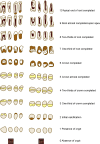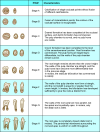Accuracy of Different Dental Age Estimation Methods Using Cone Beam Computed Tomography: A Comparative Study
- PMID: 39355178
- PMCID: PMC11440676
- DOI: 10.5005/jp-journals-10005-2860
Accuracy of Different Dental Age Estimation Methods Using Cone Beam Computed Tomography: A Comparative Study
Abstract
Background: Age assessment is useful in various fields of dentistry due to its ability to influence the planning of dental treatments. Dental age estimation methods are specifically based on age-related variables observed in two-dimensional (2D) radiographs in the dentition in terms of the time of emergence and are considered reliable in determining the chronological age; however, the inevitable problems of orientation errors found in 2D can be eliminated using cone beam computed tomography (CBCT).
Objective: This study aimed to compare the accuracy of different radiological dental age estimation methods using CBCT in relation to the chronological age of children.
Materials and methods: A total of 100 CBCT images of patients in the age-group of 8-15 years requiring orthodontic treatment were obtained from December 2019 to August 2022. The exact chronological age was determined through valid proof, that is, aadhar card or birth certificate. The dental age of the children was assessed using all four methods-Nolla's method (NM), Demirjian method (DM), Schour and Massler (S&M), and Cameriere method (CM).
Results: The results found that NM underestimated the mean age by 0.24 years, while DM overestimated the mean age by 0.82 years. Both showed statistically significant differences based on the standard deviation (SD) (p < 0.05). S&M and CM also overestimated the mean age by 1.16 years and 2.75 years respectively, but with statistically nonsignificant differences (p > 0.05).
Conclusion: Among the four tested radiographic methods, the best accuracy was found with NM, which tended to underestimate but was closest to the chronological age. CBCT provided better age estimation values without image distortion.
How to cite this article: Tyagi A, Srivastava N, Rana V, et al. Accuracy of Different Dental Age Estimation Methods Using Cone Beam Computed Tomography: A Comparative Study. Int J Clin Pediatr Dent 2024;17(5):558-564.
Keywords: Cone beam computed tomography; Demirjian method; Nolla's method; Schour and Massler.
Copyright © 2024; The Author(s).
Conflict of interest statement
Source of support: Nil Conflict of interest: NoneConflict of interest: None
Figures
References
-
- George GJ, Chatra L, Shenoy P, et al. Age determination by S&M method: a forensic study. Int J Forensic Odontol. 2018;3(1):36–39. doi: 10.4103/ijfo.ijfo_5_18. - DOI
-
- Schour I, Massler M. The development of the human dentition. J Am Den Assoc. 1941;28:1153–1160.
-
- Nolla CM. The development of permanent teeth. J Dent Child. 1960;27:254–266.
LinkOut - more resources
Full Text Sources




